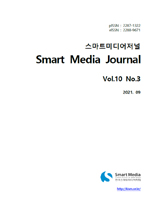머신러닝 기법을 활용한 낙동강 하구 염분농도 예측
Nakdong River Estuary Salinity Prediction Using Machine Learning Methods
- 한국스마트미디어학회
- 스마트미디어저널
- Vol11, No.2
-
2022.0331 - 38 (8 pages)
-
DOI : 10.30693/SMJ.2022.11.2.31
- 154

하천의 염분 변화를 신속히 예측하는 것은 염분 침투로 인한 농업, 생태계의 피해를 예측하고 재해 방지 대책을 수립하기 위해서 중요한 작업이다. 머신러닝 기법은 물리 기반 수리 모델에 비해 계산량이 훨씬 적기 때문에, 비교적 짧은 시간에 염분농도를 예측 가능하여 물리 기반 수리 모델의 보완 기법으로 연구되고 있다. 해외에서는 머신러닝 기법 기반 염분 예측 연구들이 활발히 연구되고 있으나, 대한민국의 공공데이터에 머신러닝 기법을 적용한 연구는 충분치 않다. 낙동강 하구의 환경 정보에 관한 공공데이터와 함께, 본 연구는 여러 종류의 머신러닝 기법의 염분농도에 대한 예측 성능을 측정하였다. 실험 결과에서, 결정 트리 기반의 LightGBM 알고리즘은 평균 RMSE 0.37의 예측 정확도와 타 알고리즘 대비 2-20배 빠른 학습 속도를 보여주었다. 따라서 국내 하천의 염분농도 예측에도 머신러닝 기법을 적용할 수 있다고 판단된다.
Promptly predicting changes in the salinity in rivers is an important task to predict the damage to agriculture and ecosystems caused by salinity infiltration and to establish disaster prevention measures. Because machine learning(ML) methods show much less computation cost than physics-based hydraulic models, they can predict the river salinity in a relatively short time. Due to shorter training time, ML methods have been studied as a complementary technique to physics-based hydraulic model. Many studies on salinity prediction based on machine learning have been studied actively around the world, but there are few studies in South Korea. With a massive number of datasets available publicly, we evaluated the performance of various kinds of machine learning techniques that predict the salinity of the Nakdong River Estuary Basin. As a result, LightGBM algorithm shows average 0.37 in RMSE as prediction performance and 2-20 times faster learning speed than other algorithms. This indicates that machine learning techniques can be applied to predict the salinity of rivers in Korea.
Ⅰ. 서론
Ⅱ. 관련 연구
Ⅲ. 염분농도 예측
Ⅳ. 실험 결과
Ⅴ. 결론
(0)
(0)